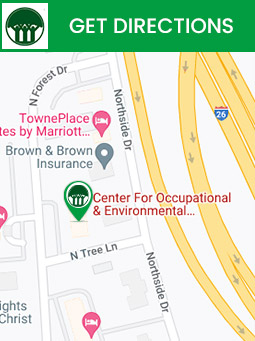Diagnosis of Chronic Inflammatory Response Syndrome (CIRS) in Charleston, SC
Chronic Inflammatory Response Syndrome (CIRS) is a complex condition, often caused by the body’s inability to properly respond to environmental toxins. Early diagnosis is crucial for effective treatment and managing symptoms. Our team at The Center for Occupational and Environmental Medicine (COEM) specializes in diagnosing and treating CIRS to improve your long-term health. For more information, contact us or schedule an appointment online. We are conveniently located at 7510 North Forest Drive North Charleston, SC 29420. Patients routinely fly in to be evaluated by COEM, as we serve patients nationally and internationally. Find out if you have been exposed, extensive lab testing is available.


Table of Contents:
How do you get diagnosed with CIRS?
How does Chronic Inflammatory Response Syndrome occur?
Can CIRS be diagnosed through a blood test?
How long does it take to diagnose CIRS?
Can a physical exam diagnose CIRS?
Diagnosis of Chronic Inflammatory Response Syndrome (CIRS) typically begins with a detailed patient history that involves examining potential exposure to mold, moisture-damaged buildings, or other sources of biotoxins. For individuals who have lived or worked in water-damaged spaces or have a known mold history, symptoms like fatigue, brain fog, joint pain, or light sensitivity can often point toward a deeper issue. The mold specialists at the Center for Occupational and Environmental Medicine (COEM) combine that symptom pattern with targeted lab testing to help determine whether CIRS is driving the chronic inflammation. While mold alone doesn’t guarantee illness, a persistent inflammatory state in someone with the right background is reason to look further. Functional medicine doctors at COEM rely on a combination of blood work, symptom scoring tools, and response tracking. Because this is frequently a biotoxin illness, identifying the exposure source, be it mold, bacteria, or water-damaged materials, is just one part. Once enough patterns line up and consistent triggers are identified, CIRS becomes the working diagnosis that guides treatment moving forward.
CIRS develops when the immune system is unable to recognize and eliminate biotoxins, or specific infections from the body. In most cases, when a person is exposed to mold or other indoor contaminants, the body tags the invader and clears it out through the liver. But for certain individuals, that process doesn’t work properly. The biotoxins continue to circulate, and over time, that constant immune activation leads to a breakdown in regulation. Instead of clearing the threat, the body stays in a loop of chronic inflammation, which can show up as everything from cognitive changes to unexplained joint or nerve symptoms.
This is frequently a response to toxic environments where poor ventilation and moisture have allowed spores and microbial fragments to build up in the air. For those with an immune system that struggles to process these toxins, even a short exposure can start a long-term inflammatory problem. Some research suggests that genetic differences may leave certain people more susceptible. Functional medicine doctors at COEM focus on a number of factors, including what symptoms are showing up, where exposure has happened, and how the individual is tolerating detox over time.
Blood testing plays a part in diagnosing CIRS, but it’s only one component of a broader clinical assessment. Lab work can show changes in inflammation markers, immune response, and other indicators that support the diagnosis, but additional assessments can be valuable in confirming the diagnosis. At COEM, functional lab testing is used to track trends and patterns that point to biotoxin exposure or immune system dysfunction. That includes looking at markers associated with chronic inflammation, hormone regulation, and specific immune proteins that may be off balance. There is no simple, singular blood test for CIRS.
Because biotoxins and infections can affect multiple systems at once, a broad approach is often more useful than chasing one lab number. Blood tests may be paired with urine analysis, symptom tracking tools, and patient history to get a clearer sense of how deep the exposure goes. And in cases where mold or water-damaged environments are suspected, specialists may also work alongside environmental professionals to ensure exposure is being addressed at the source.
The time it takes to diagnose CIRS depends on how clear the exposure history is and how the symptoms present. For individuals who already have documented mold exposure or environmental triggers, the process tends to move more quickly. If those links aren’t obvious, or if the symptoms overlap with other chronic conditions, it can take longer. At COEM, functional medicine doctors work through environmental, immune, and metabolic factors. Once testing begins, some results return quickly, while others require retesting over time. Functional lab testing may include blood, urine analysis, stool and saliva to look for immune shifts, hormonal changes, or retained biotoxins. Diagnosis also depends on how well the patient’s system responds to early intervention and whether symptoms shift with initial treatment strategies. It’s not uncommon for the full diagnostic process to take several weeks, especially when environmental assessments or outside exposures are still being addressed.
A physical exam is often part of the process, but on its own, it isn’t enough to confirm a CIRS diagnosis. Mold illness and biotoxin exposure don’t always leave obvious signs on the surface. Functional medicine doctors at COEM use the physical exam to identify patterns like sinus congestion, skin changes, balance issues, or neurological findings that can suggest chronic inflammation is affecting multiple systems. These small indicators help build the case when paired with lab results and symptom history. When taken in context with a patient’s exposure history, like living in a water-damaged building, experiencing persistent fatigue, or dealing with brain fog and memory issues, the physical exam becomes additional helpful information.
Chronic Inflammatory Response Syndrome (CIRS) assessment is available at the Center for Occupational and Environmental Medicine (COEM). For more information, contact us or schedule an appointment online. We are conveniently located at 7510 North Forest Drive North Charleston, SC 29420. We serve patients from Charleston SC, Mount Pleasant SC, Summerville SC, North Charleston SC, Goose Creek SC, Ladson SC, Hanahan SC, James Island SC, John’s Island SC, Daniel Island SC, West Ashley SC, Moncks Corner SC, Sullivans Island SC, Folly Beach SC, Isle of Palms SC and all of South Carolina, Nationally, and Internationally. Patients routinely fly into Charleston to be evaluated by COEM and to enjoy this beautiful city, which is a Condé Nast and Travel and Leisure Top Domestic and International Tourist Destination.

Additional Services You May Like
- Functional Medicine
- Allergy and Autoimmunity
- Asthma and COPD
- Autoimmune Diseases
- Allergy and Immunology
- Anti Aging Medicine
- Autism and Children
- ADHD
- Bacterial Infections
- Chemical Toxicity
- Candida Fungal Problems
- Cancer Treatment
- Chronic Illness
- Chronic Inflammatory Response Syndrome (CIRS)
- Chronic Fatigue
- Cardiovascular Disease
- Carbon Monoxide Poisoning
- Chelation Therapy
- Depression
- Environmental Medicine
- Ear Ringing and Dizziness
- Fatigue Treatment
- Fertility and Preconception Care
- Gut Health
- Heavy Metal Toxicity
- Hormonal Imbalances
- Headaches and Migraines
- Hormone Balancing (Men & Women)
- Hepatitis
- Integrative Medicine
- Independent Medical Evaluations
- Influenza
- Lab Testing
- Mold Toxicity
- Malnutrition
- Neurodegenerative Disease
- Natural Hormone Balancing For Women
- Preservative-Free IV Therapy
- Stomach Acid Imbalance
- Smoking Cessation Program
- Skin Therapy (Anti-Aging)
- Swine Flu
- Thyroid
- Mold Toxicity
- Vitamin D
- Weight Loss Program
- Women’s Breast Health Formula

Additional Services You May Like
- Functional Medicine
- Allergy and Autoimmunity
- Asthma and COPD
- Autoimmune Diseases
- Allergy and Immunology
- Anti Aging Medicine
- Autism and Children
- ADHD
- Bacterial Infections
- Chemical Toxicity
- Candida Fungal Problems
- Cancer Treatment
- Chronic Illness
- Chronic Fatigue
- Cardiovascular Disease
- Chronic Inflammatory Response Syndrome (CIRS)
- Carbon Monoxide Poisoning
- Chelation Therapy
- Depression
- Environmental Medicine
- Ear Ringing and Dizziness
- Fatigue Treatment
- Fertility and Preconception Care
- Gut Health
- Heavy Metal Toxicity
- Hormonal Imbalances
- Headaches and Migraines
- Hormone Balancing (Men & Women)
- Hepatitis
- Integrative Medicine
- Independent Medical Evaluations
- Influenza
- Lab Testing
- Mold Toxicity
- Malnutrition
- Neurodegenerative Disease
- Natural Hormone Balancing For Women
- Preservative-Free IV Therapy
- Stomach Acid Imbalance
- Smoking Cessation Program
- Skin Therapy (Anti-Aging)
- Swine Flu
- Thyroid
- Mold Toxicity
- Vitamin D
- Weight Loss Program
- Women’s Breast Health Formula










